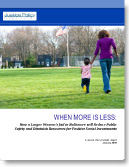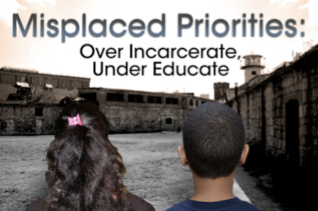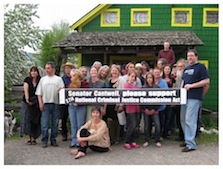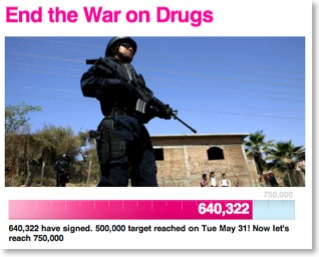News you can use
Latest News, Events and Action Alerts
Crack Retroactivity Granted!
June 30th 2011, the U.S. Sentencing Commission granted retroactivity to the Fairness in Sentencing Act.
U.S. Sentencing Commission received over 40,000 letters -- people mostly from people like you!
Media coverage of retroactivity and FSA
Witness statements before the U.S. Sentencing Commission on June 1st.
Read the Commission's Analysis of the Impact of the Fair Sentencing Act if made retroactive (2011).
U.S. Sentencing Commission received over 40,000 letters -- people mostly from people like you!
Media coverage of retroactivity and FSA
Witness statements before the U.S. Sentencing Commission on June 1st.
Read the Commission's Analysis of the Impact of the Fair Sentencing Act if made retroactive (2011).
End the War on Drugs
War on Drugs Corrupts Policing
News Channel 5 out of Middle Tennessee reports: Policing for Profit

NASHVILLE, Tenn. -- A major NewsChannel 5 investigation has uncovered serious questions about Tennessee's war on drugs. Among the questions: are some police agencies more concerned about making money off the drugs, than stopping them?

NASHVILLE, Tenn. -- A major NewsChannel 5 investigation has uncovered serious questions about Tennessee's war on drugs. Among the questions: are some police agencies more concerned about making money off the drugs, than stopping them?
AG Eric Holder's Retroactivity Testimony 6/1/2011
ATTORNEY GENERAL ERIC HOLDER SPEAKS BEFORE THE U.S. SENTENCING COMMISSION
Published 06/01/2011
Madam Chair and members of the Sentencing Commission:
Thank you for the opportunity to appear before you today. Along with my colleagues, United States Attorney Stephanie Rose and Acting Bureau of Prisons Director Tom Kane, I am here to discuss our shared goals – and this Administration’s ongoing efforts – to ensure the firm and fair administration of justice in our nation’s sentencing policies.
Thanks to the extraordinary work of this Commission – and the contributions of policymakers and prosecutors, advocates and researchers, law enforcement officers and Administration officials, as well as Congressional leaders on both sides of the aisle – in recent months, significant, long-overdue progress has been made to improve the strength and integrity of our federal sentencing system.
As we can all agree, our sentencing policies must be tough, predictable and aimed at: enhancing public safety; reducing crime; reducing recidivism; eliminating unwarranted disparities; minimizing the negative, often devastating effects of illegal drugs; and inspiring trust and confidence in the fairness of our criminal justice system.
Last August marked an historic step forward in achieving each of these goals – when President Obama signed the Fair Sentencing Act into law. This new law not only reduced the inappropriate 100-to-1 sentencing disparity between crack and powder cocaine offenses – a disparity that this Commission itself found to be unjustifiable and repeatedly recommended should be amended – it also strengthens the hand of law enforcement and includes tough new criminal penalties to mitigate the risks posed by our nation’s most serious, and most destructive, drug traffickers and violent offenders. Because of the Fair Sentencing Act, our nation is now closer to fulfilling its fundamental, and founding, promise of equal treatment under law.
But I am here today because I believe – and the Administration’s viewpoint is that - we have more to do. Although the Fair Sentencing Act is being successfully implemented nationwide, achieving its central goals of promoting public safety and public trust – and ensuring a fair and effective criminal justice system – requires the retroactive application of its guideline amendment.
Of course, in considering retroactive application of this amendment, protecting the American people is – and will remain – the Administration’s top priority. President Obama and I, along with leaders across the Administration, understand how illegal drugs – including crack – ravage communities. Crack offenders – especially violent ones – should be punished. And the Justice Department will make every effort to prosecute them. However, as years of experience and study have shown, there is simply no just or logical reason why their punishments should be dramatically more severe than those of other cocaine offenders – a position that Congress overwhelmingly supported with the passage of the Fair Sentencing Act.
The Commission’s Sentencing Guidelines already make clear that retroactivity of the guideline amendment is inappropriate when its application poses a significant risk to public safety – and the Administration agrees. In fact, we believe certain dangerous offenders – including those who have possessed or used weapons in committing their crimes and those who have significant criminal histories – should be categorically prohibited from receiving the benefits of retroactivity, a step beyond current Commission policy.
The Administration’s suggested approach to retroactivity of the amendment recognizes Congressional intent in the Fair Sentencing Act to differentiate dangerous and violent drug offenders and ensure that their sentences are no less than those originally set. However, we believe that the imprisonment terms of those sentenced pursuant to the old statutory disparity – who are not considered dangerous drug offenders – should be alleviated to the extent possible to reflect the new law.
As a federal prosecutor and as Attorney General – and as a former judge, United States Attorney, and Deputy Attorney General – this issue is deeply personal to me. While serving on the bench, here in Washington, D.C., in the late ‘80’s and early ‘90’s, I saw the devastating effects of illegal drugs on families, communities, and individual lives. I know what it is like to sentence young offenders to long prison terms, and I did so to protect the public from those who were serious threats and who had engaged in violence. However, throughout my tenure as this city’s U.S. Attorney, I also saw that our federal crack sentencing laws did not achieve that result. Our drug laws were not perceived as fair and our law enforcement efforts suffered as a result. That is why it was a special privilege for me to stand with President Obama when he signed the Fair Sentencing Act into law. And that is why I feel compelled to be here in person today, to join my colleagues in calling for the retroactive application of the guideline amendment.
I recognize that some disagree with this approach. We have heard this before. In 2008, after the Commission decided to apply retroactively an amendment that reduced the base offense level for crack by two levels – known as the “crack minus two” amendment – some, including several within the Justice Department, predicted that such a move would cause a dramatic rise in crime rates. However, as a study released by the Commission just yesterday shows, those whose sentences were reduced after that amendment was applied retroactively actually had a slightly lower rate of recidivism than the study’s control group.
Three years ago, the Bureau of Prisons, Marshals Service, federal prosecutors, judges, probation officers, and others stepped up and did the necessary work to ensure the successful and effective retroactive application of the “crack minus two” amendment. Today – despite growing demands and limited budgets – my colleagues across the Department of Justice and the criminal justice community stand ready to do that which is necessary to make our sentencing system fairer and more effective. And, once again, we are relying on the Commission to lead the way.
Recently, some have suggested that – since the Fair Sentencing Act contains no specific provision regarding retroactivity – it is beyond the role of the Sentencing Commission to make the guideline amendment retroactive without direction from the Legislative Branch. We disagree with this position. Based on the Commission’s authorizing statute, we believe that the Commission would be well within its authority to make the Fair Sentencing Act amendment retroactive along the lines that we suggest.
Madam Chair, and distinguished members of the Commission, it is time to honor, not only the letter of this law, but also the spirit of its intent. Our nation’s ability to do so rests in your hands.
Again, I want to thank you for the opportunity to appear before you. I look forward to continuing to work with each of you – and with leaders across Congress and the Administration – to strengthen federal sentencing policy, and to ensure that our nation’s criminal justice system serves as a model of effectiveness and fairness.
I’m now pleased to turn this over to my colleagues, U.S. Attorney Rose and Acting Director Kane. They will elaborate further on the Administration’s position and also will be available to answer questions.
Thank you.
Published 06/01/2011
Madam Chair and members of the Sentencing Commission:
Thank you for the opportunity to appear before you today. Along with my colleagues, United States Attorney Stephanie Rose and Acting Bureau of Prisons Director Tom Kane, I am here to discuss our shared goals – and this Administration’s ongoing efforts – to ensure the firm and fair administration of justice in our nation’s sentencing policies.
Thanks to the extraordinary work of this Commission – and the contributions of policymakers and prosecutors, advocates and researchers, law enforcement officers and Administration officials, as well as Congressional leaders on both sides of the aisle – in recent months, significant, long-overdue progress has been made to improve the strength and integrity of our federal sentencing system.
As we can all agree, our sentencing policies must be tough, predictable and aimed at: enhancing public safety; reducing crime; reducing recidivism; eliminating unwarranted disparities; minimizing the negative, often devastating effects of illegal drugs; and inspiring trust and confidence in the fairness of our criminal justice system.
Last August marked an historic step forward in achieving each of these goals – when President Obama signed the Fair Sentencing Act into law. This new law not only reduced the inappropriate 100-to-1 sentencing disparity between crack and powder cocaine offenses – a disparity that this Commission itself found to be unjustifiable and repeatedly recommended should be amended – it also strengthens the hand of law enforcement and includes tough new criminal penalties to mitigate the risks posed by our nation’s most serious, and most destructive, drug traffickers and violent offenders. Because of the Fair Sentencing Act, our nation is now closer to fulfilling its fundamental, and founding, promise of equal treatment under law.
But I am here today because I believe – and the Administration’s viewpoint is that - we have more to do. Although the Fair Sentencing Act is being successfully implemented nationwide, achieving its central goals of promoting public safety and public trust – and ensuring a fair and effective criminal justice system – requires the retroactive application of its guideline amendment.
Of course, in considering retroactive application of this amendment, protecting the American people is – and will remain – the Administration’s top priority. President Obama and I, along with leaders across the Administration, understand how illegal drugs – including crack – ravage communities. Crack offenders – especially violent ones – should be punished. And the Justice Department will make every effort to prosecute them. However, as years of experience and study have shown, there is simply no just or logical reason why their punishments should be dramatically more severe than those of other cocaine offenders – a position that Congress overwhelmingly supported with the passage of the Fair Sentencing Act.
The Commission’s Sentencing Guidelines already make clear that retroactivity of the guideline amendment is inappropriate when its application poses a significant risk to public safety – and the Administration agrees. In fact, we believe certain dangerous offenders – including those who have possessed or used weapons in committing their crimes and those who have significant criminal histories – should be categorically prohibited from receiving the benefits of retroactivity, a step beyond current Commission policy.
The Administration’s suggested approach to retroactivity of the amendment recognizes Congressional intent in the Fair Sentencing Act to differentiate dangerous and violent drug offenders and ensure that their sentences are no less than those originally set. However, we believe that the imprisonment terms of those sentenced pursuant to the old statutory disparity – who are not considered dangerous drug offenders – should be alleviated to the extent possible to reflect the new law.
As a federal prosecutor and as Attorney General – and as a former judge, United States Attorney, and Deputy Attorney General – this issue is deeply personal to me. While serving on the bench, here in Washington, D.C., in the late ‘80’s and early ‘90’s, I saw the devastating effects of illegal drugs on families, communities, and individual lives. I know what it is like to sentence young offenders to long prison terms, and I did so to protect the public from those who were serious threats and who had engaged in violence. However, throughout my tenure as this city’s U.S. Attorney, I also saw that our federal crack sentencing laws did not achieve that result. Our drug laws were not perceived as fair and our law enforcement efforts suffered as a result. That is why it was a special privilege for me to stand with President Obama when he signed the Fair Sentencing Act into law. And that is why I feel compelled to be here in person today, to join my colleagues in calling for the retroactive application of the guideline amendment.
I recognize that some disagree with this approach. We have heard this before. In 2008, after the Commission decided to apply retroactively an amendment that reduced the base offense level for crack by two levels – known as the “crack minus two” amendment – some, including several within the Justice Department, predicted that such a move would cause a dramatic rise in crime rates. However, as a study released by the Commission just yesterday shows, those whose sentences were reduced after that amendment was applied retroactively actually had a slightly lower rate of recidivism than the study’s control group.
Three years ago, the Bureau of Prisons, Marshals Service, federal prosecutors, judges, probation officers, and others stepped up and did the necessary work to ensure the successful and effective retroactive application of the “crack minus two” amendment. Today – despite growing demands and limited budgets – my colleagues across the Department of Justice and the criminal justice community stand ready to do that which is necessary to make our sentencing system fairer and more effective. And, once again, we are relying on the Commission to lead the way.
Recently, some have suggested that – since the Fair Sentencing Act contains no specific provision regarding retroactivity – it is beyond the role of the Sentencing Commission to make the guideline amendment retroactive without direction from the Legislative Branch. We disagree with this position. Based on the Commission’s authorizing statute, we believe that the Commission would be well within its authority to make the Fair Sentencing Act amendment retroactive along the lines that we suggest.
Madam Chair, and distinguished members of the Commission, it is time to honor, not only the letter of this law, but also the spirit of its intent. Our nation’s ability to do so rests in your hands.
Again, I want to thank you for the opportunity to appear before you. I look forward to continuing to work with each of you – and with leaders across Congress and the Administration – to strengthen federal sentencing policy, and to ensure that our nation’s criminal justice system serves as a model of effectiveness and fairness.
I’m now pleased to turn this over to my colleagues, U.S. Attorney Rose and Acting Director Kane. They will elaborate further on the Administration’s position and also will be available to answer questions.
Thank you.
Getting Crack Retroactivity!
The US Sentencing Commission has extended invitation for public comments on retroactivity of the Fairness in Sentencing Act until June, 1, 2011. The Commission wants to hear from you regarding crack cocaine sentencing retroactivity. Consider sending the letter we suggested Razor Wire readers personalize for the Commission.
Read the Commission's Analysis of the Impact of the Fair Sentencing Act if made retroactive (2011).
The New York Times is covering what the report describes as a "Judicial Renaissance." Read, Judges See Sentencing Injustice, but the Calendar Disagrees.
Washington Post has a February 2011 Editorial in support of crack retroactivity.
The Sentencing Project has a more information about the crack cocaine disparity and changes in 2010 law.
The Federal office of public defender's website has legal resources on recent cocaine sentencing changes.
Families Against Mandatory Minimum Sentencing - FAMM has a resources guide on new crack law and retroactivity.
Read the Commission's Analysis of the Impact of the Fair Sentencing Act if made retroactive (2011).
The New York Times is covering what the report describes as a "Judicial Renaissance." Read, Judges See Sentencing Injustice, but the Calendar Disagrees.
Washington Post has a February 2011 Editorial in support of crack retroactivity.
The Sentencing Project has a more information about the crack cocaine disparity and changes in 2010 law.
The Federal office of public defender's website has legal resources on recent cocaine sentencing changes.
Families Against Mandatory Minimum Sentencing - FAMM has a resources guide on new crack law and retroactivity.
The Injustice of Sentencing Guidelines
March 23, 2011 -- The Atlantic
Glenna Hall, a retired Washington State superior court judge writes "For me, sentencing, particularly for drug crimes, was in many ways the hardest part of my work as a judge. Not because the decisions or the work were hard (though of course they were), but because, given the restrictive nature of the sentencing guidelines in Washington, I had virtually no discretion or authority to consider anything about the human being standing before me. I could consider only the nature of the crime, expressed in a number, and the number and kinds of offenses the defendant had committed, also expressed in a number. From those two quantified factors was derived a quite narrow range I was required to use in imposing a sentence. Except in a minuscule set of circumstances, I could only work within that range. The temptation not to think at all but rather to pick a number in the middle was strong."
Read the entire article here
Glenna Hall, a retired Washington State superior court judge writes "For me, sentencing, particularly for drug crimes, was in many ways the hardest part of my work as a judge. Not because the decisions or the work were hard (though of course they were), but because, given the restrictive nature of the sentencing guidelines in Washington, I had virtually no discretion or authority to consider anything about the human being standing before me. I could consider only the nature of the crime, expressed in a number, and the number and kinds of offenses the defendant had committed, also expressed in a number. From those two quantified factors was derived a quite narrow range I was required to use in imposing a sentence. Except in a minuscule set of circumstances, I could only work within that range. The temptation not to think at all but rather to pick a number in the middle was strong."
Read the entire article here
DOJ offering a good time increase
Wall Street Journal reviews documents
"At the Justice Department, officials are considering whether to shorten some federal prison terms and have already shut down a program that successfully encouraged fugitive criminals to turn themselves in."
Devlln Barrett of the Wall Street Journal reported Jan 27, 2011 that documents released to the WSJ show that 4,000 federal prisoners would immediately qualify for release.
"—Increasing the amount of time deducted from prison terms for good behavior, which would immediately qualify some 4,000 federal convicts for release, and another 4,000 over the next 10 years." Read the article and commentary at the Wall St. Journal.
Details have not yet emerged, and the budget adjusting 'as we speak.' We urge November members to contact the White House urging president Obama to do more to restore justice to the federal sentencing system.
"At the Justice Department, officials are considering whether to shorten some federal prison terms and have already shut down a program that successfully encouraged fugitive criminals to turn themselves in."
Devlln Barrett of the Wall Street Journal reported Jan 27, 2011 that documents released to the WSJ show that 4,000 federal prisoners would immediately qualify for release.
"—Increasing the amount of time deducted from prison terms for good behavior, which would immediately qualify some 4,000 federal convicts for release, and another 4,000 over the next 10 years." Read the article and commentary at the Wall St. Journal.
Details have not yet emerged, and the budget adjusting 'as we speak.' We urge November members to contact the White House urging president Obama to do more to restore justice to the federal sentencing system.
Ten years for $31 of marijuana
Ten years for $31 of marijuana - March 2012
Patricia Marilyn Spottedcrow, a 25-year-old mother of four, and her mother, Delita Starr, 50, sold an $11 "dime bag" of marijuana to a police informant in Oklahoma on Dec. 31, 2009. The informant returned two weeks later to buy $20 of marijuana. Spottedcrow, who worked in nursing homes before her arrest, and she told The Oklahoman she did it to get some extra money.
To read what your state leaders have to say about marijuana laws, check out NORML's your politicians on pot.

Patricia Marilyn Spottedcrow, a 25-year-old mother of four, and her mother, Delita Starr, 50, sold an $11 "dime bag" of marijuana to a police informant in Oklahoma on Dec. 31, 2009. The informant returned two weeks later to buy $20 of marijuana. Spottedcrow, who worked in nursing homes before her arrest, and she told The Oklahoman she did it to get some extra money.
To read what your state leaders have to say about marijuana laws, check out NORML's your politicians on pot.
No Obama Budget Freeze for Prisons
From Mother Jones Magazine
No Obama Budget Freeze for Prisons
— By James Ridgeway| Mon Feb. 22, 2010 1:39 PM PST
In the nation with the world’s highest incarceration rate, amid talk of dangerously high deficits and budget freezes, the White House proposes dramatically increasing spending on prisons.
A newly released report from the Justice Policy Institute, titled "The Obama Administration’s 2011 Budget: More Policing, Prisons, and Punitive Policies," analyzes the priorities reflected in the president’s overall spending plans for the Department of Justice in FY 2011 (which begins on October 1, 2010):
The President’s proposed FY2011 Department of Justice (DOJ) budget asks for $29.2 billion. This is on top of $4 billion provided to DOJ through the American Reinvestment and Recovery Act (ARRA), much of which will continue to fund activities through 2011 and beyond. Although the budget has some specific allocations for juvenile justice that it had removed last year, it still reduces spending on juvenile justice programs, while allocating hundreds of millions to hire or retain police officers….and increasing federal prison spending. Read the article.
No Obama Budget Freeze for Prisons
— By James Ridgeway| Mon Feb. 22, 2010 1:39 PM PST
In the nation with the world’s highest incarceration rate, amid talk of dangerously high deficits and budget freezes, the White House proposes dramatically increasing spending on prisons.
A newly released report from the Justice Policy Institute, titled "The Obama Administration’s 2011 Budget: More Policing, Prisons, and Punitive Policies," analyzes the priorities reflected in the president’s overall spending plans for the Department of Justice in FY 2011 (which begins on October 1, 2010):
The President’s proposed FY2011 Department of Justice (DOJ) budget asks for $29.2 billion. This is on top of $4 billion provided to DOJ through the American Reinvestment and Recovery Act (ARRA), much of which will continue to fund activities through 2011 and beyond. Although the budget has some specific allocations for juvenile justice that it had removed last year, it still reduces spending on juvenile justice programs, while allocating hundreds of millions to hire or retain police officers….and increasing federal prison spending. Read the article.
Patricia Spottedcrow -- Update March 24, 2011
Patricia Spottedcrow -- Update. Tulsa World say s Okalahoman article results in global support for Patricia's release.
s Okalahoman article results in global support for Patricia's release.
The Tulsa World in partnership with Oklahoma Watch, an independent, nonprofit, investigative and in-depth reporting team presents Women in Prison. Did you know Oklahoma incarcerates more women than any other state? Take a look inside.
To contact Okalahoma's Governor Mary Fallin you can write:
Oklahoma State Capitol
2300 N. Lincoln Blvd., Room 212
Oklahoma City, OK 73105
E-mail: info@gov.ok.gov - Call (405) 521-2342 or Fax: (405) 521-3353
Patricia Marilyn Spottedcrow, a 25-year-old mother of four, and her mother, Delita Starr, 50, sold an $11 "dime bag" of marijuana to a police informant in Oklahoma on Dec. 31, 2009. The informant returned two weeks later to buy $20 of marijuana. Spottedcrow, who worked in nursing homes before her arrest, told The Oklahoman in March 2011 -- she did it to get some extra money.

The Tulsa World in partnership with Oklahoma Watch, an independent, nonprofit, investigative and in-depth reporting team presents Women in Prison. Did you know Oklahoma incarcerates more women than any other state? Take a look inside.
To contact Okalahoma's Governor Mary Fallin you can write:
Oklahoma State Capitol
2300 N. Lincoln Blvd., Room 212
Oklahoma City, OK 73105
E-mail: info@gov.ok.gov - Call (405) 521-2342 or Fax: (405) 521-3353
Patricia Marilyn Spottedcrow, a 25-year-old mother of four, and her mother, Delita Starr, 50, sold an $11 "dime bag" of marijuana to a police informant in Oklahoma on Dec. 31, 2009. The informant returned two weeks later to buy $20 of marijuana. Spottedcrow, who worked in nursing homes before her arrest, told The Oklahoman in March 2011 -- she did it to get some extra money.
Eliminating Solitary in Colorado
Colorado legislation would eliminate over-use of solitary confinement
SB 176 creates requirements to be met before a state inmate, particularly an inmate with a serious mental illness, may be placed in administrative segregation
Supporters of SB 176 believe that the Colorado Department of Corrections is overusing expensive solitary confinement beds as a management tool for those afflicted with a serious mental illness rather than expanding mental health and behavioral health services. Colorado can’t afford to continue to make this choice. It is also bad public policy to allow people who have been contained in administrative segregation for long periods of time to be directly released into the community with minimal preparation. SB176 addresses those concerns and creates a process so that we may start to alleviate these issues, visit the Colorado Coalition for Criminal Justice Reform to learn more.
SB 176 creates requirements to be met before a state inmate, particularly an inmate with a serious mental illness, may be placed in administrative segregation
Supporters of SB 176 believe that the Colorado Department of Corrections is overusing expensive solitary confinement beds as a management tool for those afflicted with a serious mental illness rather than expanding mental health and behavioral health services. Colorado can’t afford to continue to make this choice. It is also bad public policy to allow people who have been contained in administrative segregation for long periods of time to be directly released into the community with minimal preparation. SB176 addresses those concerns and creates a process so that we may start to alleviate these issues, visit the Colorado Coalition for Criminal Justice Reform to learn more.
Current Studies and Reports
 Betraying the Model City: How Gang Injunctions Fail Oakland, Critical Resistance -- February 2011 Research findings conclude that civil gang injunctions are an inappropriate method for addressing violence in our communities. Injunctions lead to increased police harassment and brutality, decreased community unity, increased alienation and racial profiling, and gentrification. They also divert a tremendous amount of resources from vital programs that could build strong, stable and healthy communities. Full Report here.
Betraying the Model City: How Gang Injunctions Fail Oakland, Critical Resistance -- February 2011 Research findings conclude that civil gang injunctions are an inappropriate method for addressing violence in our communities. Injunctions lead to increased police harassment and brutality, decreased community unity, increased alienation and racial profiling, and gentrification. They also divert a tremendous amount of resources from vital programs that could build strong, stable and healthy communities. Full Report here.
 When More is Less: How a Larger Women’s Jail in Baltimore will Reduce Public Safety and Diminish Resources for Positive Social Investments
January 5, 2011 - Justice Policy Institute
When More is Less: How a Larger Women’s Jail in Baltimore will Reduce Public Safety and Diminish Resources for Positive Social Investments
January 5, 2011 - Justice Policy Institute
“Crime rates and arrests have fallen dramatically in Baltimore City,” said Tracy Velázquez, executive director of JPI. “The State projected just the opposite, and plans for the new women’s pretrial facility reflect this inaccurate forecasting; the plans call for 800 beds when half that number are currently being used. Maryland taxpayers cannot afford to build this proposed $181 million behemoth of a jail, let alone staff and maintain it. Better, less expensive options are available to protect public safety and ensure people make their court dates.”
Download summary, fact sheets and full report here.
 From the Mountaintops, What the World Can Learn from Drug Policy Change in Switzerland
From the Mountaintops, What the World Can Learn from Drug Policy Change in Switzerland
Author, Joanne Csete
Published by the Open Society Foundations, this report looks at how evidence-based services such as heroin treatment, injection rooms, and needle exchange can lower HIV infection rates, improve health outcomes, and lower crime rates. Health professionals who were persuaded that the harms of drug injection could be controlled more effectively by public health programs than by policing were at the vanguard of shifting the parameters of Swiss drug policy.
Download this report.
Misplaced Priorities: a new report from NAACP
April 7, 2011
The NAACP's new report, Misplaced Priorities, examines America's escalating levels of prison spending, tracking the steady shift of state funds away from education and toward the criminal justice system.
Researchers have found that over-incarceration most often impacts vulnerable and minority populations, and that it destabilizes communities.
The report is part of the “Smart and Safe Campaign,” and the NAACP is urging everyone to sign its petition to urge governors to adopt a set of recommendations that will help policymakers in all 50 states downsize prison populations and shift the savings to education budgets.

The NAACP's new report, Misplaced Priorities, examines America's escalating levels of prison spending, tracking the steady shift of state funds away from education and toward the criminal justice system.
Researchers have found that over-incarceration most often impacts vulnerable and minority populations, and that it destabilizes communities.
The report is part of the “Smart and Safe Campaign,” and the NAACP is urging everyone to sign its petition to urge governors to adopt a set of recommendations that will help policymakers in all 50 states downsize prison populations and shift the savings to education budgets.
Addicted to Courts
March 22, 2011
The Justice Policy Institute released Addicted to Courts: How a Growing Dependence on Drug Courts Impacts People and Communities, which finds that providing people with alternatives like community-based treatment are more cost-effective and provide greater public safety benefits than treatment that comes with the collateral consequences associated with involvement in the criminal justice system.
Read the report here
The Justice Policy Institute released Addicted to Courts: How a Growing Dependence on Drug Courts Impacts People and Communities, which finds that providing people with alternatives like community-based treatment are more cost-effective and provide greater public safety benefits than treatment that comes with the collateral consequences associated with involvement in the criminal justice system.
Read the report here
Drug Courts Are Not the Answer
March 22, 2011
New Report Finds “Drug Courts Are Not the Answer: Have Not Demonstrated Cost Savings, Reduced Incarceration or Improved Public Safety
Washington, D.C. – Drug Policy Alliance released a groundbreaking new report, Drug Courts are Not the Answer: Toward a Health-Centered Approach to Drug Use (www.drugpolicy.org/drugcourts), which finds that drug courts have not demonstrated cost savings, reduced incarceration, or improved public safety; leave many people worse off for trying; and have actually made the criminal justice system more punitive toward addiction – not less.
“The drug court phenomenon is, in large part, a case of good intensions being mistaken for a good idea,” said Margaret Dooley-Sammuli, deputy state director in Southern California for the Drug Policy Alliance, who contributed to the report. “Drug courts have helped many people, but they have also failed many others, focused resources on people who could be better treated outside the criminal justice system and in some cases even led to increased incarceration. As long as they focus on people whose only crime is their health condition, drug courts will be part of the problem – not the solution – created by drug war policies.”
Read background and complete report here
New Report Finds “Drug Courts Are Not the Answer: Have Not Demonstrated Cost Savings, Reduced Incarceration or Improved Public Safety
Washington, D.C. – Drug Policy Alliance released a groundbreaking new report, Drug Courts are Not the Answer: Toward a Health-Centered Approach to Drug Use (www.drugpolicy.org/drugcourts), which finds that drug courts have not demonstrated cost savings, reduced incarceration, or improved public safety; leave many people worse off for trying; and have actually made the criminal justice system more punitive toward addiction – not less.
“The drug court phenomenon is, in large part, a case of good intensions being mistaken for a good idea,” said Margaret Dooley-Sammuli, deputy state director in Southern California for the Drug Policy Alliance, who contributed to the report. “Drug courts have helped many people, but they have also failed many others, focused resources on people who could be better treated outside the criminal justice system and in some cases even led to increased incarceration. As long as they focus on people whose only crime is their health condition, drug courts will be part of the problem – not the solution – created by drug war policies.”
Read background and complete report here
$75 Million a Year
On March 15th, 2010 in New York City, council members, people who endured incarceration on a marijuana charge, and the authors of the report, $75 Million a Year: The Cost of New York City Marijuana Possession Arrests gathered on the steps of City Hall to call special attention to its release.
There was an important press conference on the steps of City Hall today to release a new report on the fiscal costs of the 50,000 marijuana arrests in New York City in 2010.
Statements from dozens of community groups describing how they would make better use of the $75 million dollars NYPD uses on marijuana arrests were presented with the evidence of failed drug policy. Read the report
There was an important press conference on the steps of City Hall today to release a new report on the fiscal costs of the 50,000 marijuana arrests in New York City in 2010.
Statements from dozens of community groups describing how they would make better use of the $75 million dollars NYPD uses on marijuana arrests were presented with the evidence of failed drug policy. Read the report
Increased Support for Legalization of Marijuana
Increased Support for Legalization of Marijuana
March 3, 2011
In a report titled, Fewer Are Angry at Government, But Discontent Remains High amid other issues once polarizing it's revealed that today the public is divided over whether the use of marijuana should be legal or not. Half of people surveyed (50%) oppose legalization while nearly as many (45%) favor legalizing marijuana. Support for legalizing marijuana is up slightly since March, 2010; and over the past 40 years – drawing on trends from Gallup and the General Social Survey – support for legalizing marijuana has never been higher. Read the report and accompanying data at the Pew Research Center for the People and the Press.
March 3, 2011
In a report titled, Fewer Are Angry at Government, But Discontent Remains High amid other issues once polarizing it's revealed that today the public is divided over whether the use of marijuana should be legal or not. Half of people surveyed (50%) oppose legalization while nearly as many (45%) favor legalizing marijuana. Support for legalizing marijuana is up slightly since March, 2010; and over the past 40 years – drawing on trends from Gallup and the General Social Survey – support for legalizing marijuana has never been higher. Read the report and accompanying data at the Pew Research Center for the People and the Press.
Betraying the Model City, February 2011
 Betraying the Model City: How Gang Injunctions Fail Oakland, Critical Resistance -- February 2011
Betraying the Model City: How Gang Injunctions Fail Oakland, Critical Resistance -- February 2011 When More is Less, January 2011

“Crime rates and arrests have fallen dramatically in Baltimore City,” said Tracy Velázquez, executive director of JPI. “The State projected just the opposite, and plans for the new women’s pretrial facility reflect this inaccurate forecasting; the plans call for 800 beds when half that number are currently being used. Maryland taxpayers cannot afford to build this proposed $181 million behemoth of a jail, let alone staff and maintain it. Better, less expensive options are available to protect public safety and ensure people make their court dates.”
Download summary, fact sheets and full report here.
Collateral Costs - September 2010
Pew Economic Policy Group, September 28, 2010
Summary: Collateral Costs: Incarceration’s Effect on Economic Mobility is a collaborative effort between Pew’s Economic Mobility Project and its Public Safety Performance Project. The report examines the impact of incarceration on the economic mobility of former inmates and their families. In addition, Collateral Costs finds that incarceration reduces former inmates’ earnings by 40 percent, limits their future economic mobility and that one in every 28 children in America has a parent behind bars, up from one in 125 just 25 years ago.
Summary: Collateral Costs: Incarceration’s Effect on Economic Mobility is a collaborative effort between Pew’s Economic Mobility Project and its Public Safety Performance Project. The report examines the impact of incarceration on the economic mobility of former inmates and their families. In addition, Collateral Costs finds that incarceration reduces former inmates’ earnings by 40 percent, limits their future economic mobility and that one in every 28 children in America has a parent behind bars, up from one in 125 just 25 years ago.
Money Well Spent, September 2010
Money Well Spent: How positive social investments will reduce incarceration rates, improve public safety, and promote the well-being of communities.
September 16, 2010–– Justice Policy Institute
Greater benefits will be realized by focusing spending on positive social services that improve public safety rather than expanding corrections and law enforcement. Read more about report and links to the full report, here.

September 16, 2010–– Justice Policy Institute
Greater benefits will be realized by focusing spending on positive social services that improve public safety rather than expanding corrections and law enforcement. Read more about report and links to the full report, here.
Racist Marijuana Laws, June 2010
June 2010 - Drug Policy Alliance
Drug Policy Alliance has released a report that documents widespread race-based disparities in the enforcement of low-level marijuana possession laws in California. The report finds that African Americans are arrested for marijuana possession at double, triple or even quadruple the rate of whites. Read the report (PDF)
Drug Policy Alliance has released a report that documents widespread race-based disparities in the enforcement of low-level marijuana possession laws in California. The report finds that African Americans are arrested for marijuana possession at double, triple or even quadruple the rate of whites. Read the report (PDF)
From the Mountain Tops, October 2010

Author, Joanne Csete
Published by the Open Society Foundations, this report looks at how evidence-based services such as heroin treatment, injection rooms, and needle exchange can lower HIV infection rates, improve health outcomes, and lower crime rates. Health professionals who were persuaded that the harms of drug injection could be controlled more effectively by public health programs than by policing were at the vanguard of shifting the parameters of Swiss drug policy.
Download this report.
World Prison Population List, 2010
May 2010 - International Centre for Prison Studies, King's College London
The eighth edition of the World Prison Population List gives details of the number of prisoners held in 218 independent countries and dependent territories. The United States has the highest prison population rate in the world, 756 per 100,000 of the national population, followed by Russia (629), Rwanda (604), St Kitts & Nevis (588), Cuba (c.531), U.S. Virgin Is. (512), British Virgin Is. (488), Palau (478), Belarus (468), Belize (455), Bahamas (422), Georgia (415), American Samoa (410), Grenada (408) and Anguilla (401).
Download Report
The eighth edition of the World Prison Population List gives details of the number of prisoners held in 218 independent countries and dependent territories. The United States has the highest prison population rate in the world, 756 per 100,000 of the national population, followed by Russia (629), Rwanda (604), St Kitts & Nevis (588), Cuba (c.531), U.S. Virgin Is. (512), British Virgin Is. (488), Palau (478), Belarus (468), Belize (455), Bahamas (422), Georgia (415), American Samoa (410), Grenada (408) and Anguilla (401).
Download Report
Prison Count 2010
April 2010 — Pew Center of the States
Prison Count 2010: State Population Declines for the First Time in 38 Years
For the first time in nearly 40 years, the number of state prisoners in the United States has declined, marking the first year-to-year drop in the state prison population since 1972. In this period, however, the nation’s total prison population increased by 2,061 people because of a jump in the number of inmates under the jurisdiction of the federal Bureau of prisons. The federal count rose by 6,838 prisoners, or 3.4 percent in 2009, to an all-time high of 208,118.
Download Report
Download Errata
Prison Count 2010: State Population Declines for the First Time in 38 Years
For the first time in nearly 40 years, the number of state prisoners in the United States has declined, marking the first year-to-year drop in the state prison population since 1972. In this period, however, the nation’s total prison population increased by 2,061 people because of a jump in the number of inmates under the jurisdiction of the federal Bureau of prisons. The federal count rose by 6,838 prisoners, or 3.4 percent in 2009, to an all-time high of 208,118.
Download Report
Download Errata
Drug Law Enforcement and Violence, March 2010
Smart Justice for Florida, February 2010
February 2010 - Collins Center for Public Policy
Smart Justice: Findings and Recommendations for Florida Criminal Justice Reform
With Florida’s prison population now surpassing the 100,000 mark, powerful voices, a growing number
from the business community, are speaking out about the alarming rate of prison growth and the unsustainable spending necessary to maintain it. They are striking a chord of urgency, saying we cannot continue on this path. We must find better ways to achieve a safer, more rational and more cost-effective criminal justice system.
Download the Report
Smart Justice: Findings and Recommendations for Florida Criminal Justice Reform
With Florida’s prison population now surpassing the 100,000 mark, powerful voices, a growing number
from the business community, are speaking out about the alarming rate of prison growth and the unsustainable spending necessary to maintain it. They are striking a chord of urgency, saying we cannot continue on this path. We must find better ways to achieve a safer, more rational and more cost-effective criminal justice system.
Download the Report
Business Leaders Want Less Incarceration, Jan 2010
January, 2010 - Pew Center of the States
Right-Sizing Prisons: Business Leaders Make the Case for Corrections Reform
You don’t normally see the business community leading efforts to reform state policies on public safety issues, yet in several states around the country business leaders are doing just that. With states facing the worst fiscal crisis in a generation and spending one in every 15 state discretionary dollars on corrections,1 business leaders are adding their voices to calls for more cost-effective ways to protect public safety and hold offenders accountable, while also providing the education and infrastructure they need for a thriving economy.
Download the Report
Right-Sizing Prisons: Business Leaders Make the Case for Corrections Reform
You don’t normally see the business community leading efforts to reform state policies on public safety issues, yet in several states around the country business leaders are doing just that. With states facing the worst fiscal crisis in a generation and spending one in every 15 state discretionary dollars on corrections,1 business leaders are adding their voices to calls for more cost-effective ways to protect public safety and hold offenders accountable, while also providing the education and infrastructure they need for a thriving economy.
Download the Report
Rape, Sexual Abuse in Juvenile Prisons, Jan 2010
January 7, 2010 -- US Bureau of Justice Statistics
Rape, Sexual Abuse in Juvenile Corrections Facilities
Bureau of Justice Statistics study exposes epidemic of abuse in juvenile facilities, underscores call for new standards
Full report and press release
Rape, Sexual Abuse in Juvenile Corrections Facilities
Bureau of Justice Statistics study exposes epidemic of abuse in juvenile facilities, underscores call for new standards
Full report and press release
Incarcerated Women and Their Children, Jan 2010
January 22 2010 - Oklahoma Commission on Children and Youth
Study of Incarcerated Women and Their Children
Oklahoma continues to lead the country in incarceration of women. Its female prison population is the largest per capita in the country, with 2,693 prisoners as of September 30, 2009. Female inmates are almost twice as likely as male inmates to report that they had a child of their own living with them prior to their arrest. Thus, their imprisonment is more likely to disrupt their children’s living arrangements.
Download Report
Study of Incarcerated Women and Their Children
Oklahoma continues to lead the country in incarceration of women. Its female prison population is the largest per capita in the country, with 2,693 prisoners as of September 30, 2009. Female inmates are almost twice as likely as male inmates to report that they had a child of their own living with them prior to their arrest. Thus, their imprisonment is more likely to disrupt their children’s living arrangements.
Download Report
Deterring Staff Sexual Abuse of Federal Inmates
US Department of Justice, March 2011 Report
Deterring Staff Sexual Abuse of Federal Inmates
"No matter how strong the final standards are, they will be meaningless if they do not require detention facilities to be subject to independent, external oversight. The U.S. already runs what are widely considered the least transpar- ent prisons in the Western world. Yet, in its recommended standards, the Department of Justice proposes allowing corrections agencies to use an internal employee for measuring compliance with the standards."
Deterring Staff Sexual Abuse of Federal Inmates
"No matter how strong the final standards are, they will be meaningless if they do not require detention facilities to be subject to independent, external oversight. The U.S. already runs what are widely considered the least transpar- ent prisons in the Western world. Yet, in its recommended standards, the Department of Justice proposes allowing corrections agencies to use an internal employee for measuring compliance with the standards."
Special Issues of Interest
Informants & the Drug War
"Snitching" or the use of informants in the drug war continues to be an issue the creates enormous havoc in communities and drug defendant's lives. At this small, but special section, you can explore the latest news articles, commentary research as well as some of the classics like the documentary, SNITCH. Read more.
Federal Sentencing, Policing, and Drug Policy Bills in the 112th Congress
Bill summaries below include links to the online congressional resource pages at Thomas.gov where you can find daily, up-to-date information.
In the House of Representatives
HR 223 - Nonviolent Offender Relief Act
Rep Jackson Lee, Sheila [TX-18] (introduced 1/7/2011)
Federal Prison Bureau Nonviolent Offender Relief Act of 2011 - Amends the federal criminal code to direct the Bureau of Prisons, pursuant to a good time policy, to release a prisoner who has served one half or more of his or her term of imprisonment if that prisoner: (1) has attained age 45; (2) has never been convicted of a crime of violence; and (3) has not engaged in any violation, involving violent conduct, of institutional disciplinary regulations.
You can follow this, and related bills by visiting this link at Thomas.gov
Federal Prison Bureau Nonviolent Offender Relief Act of 2011 - Amends the federal criminal code to direct the Bureau of Prisons, pursuant to a good time policy, to release a prisoner who has served one half or more of his or her term of imprisonment if that prisoner: (1) has attained age 45; (2) has never been convicted of a crime of violence; and (3) has not engaged in any violation, involving violent conduct, of institutional disciplinary regulations.
You can follow this, and related bills by visiting this link at Thomas.gov
In the Senate
S 306 - National Criminal Justice Commission Act
Sponsor: Sen Webb, Jim [VA], introduced 2/8/2011
SUMMARY AS OF: 2/8/2011
National Criminal Justice Commission Act of 2011 - Establishes the National Criminal Justice Commission.
Directs the Commission to: (1) review all areas of the criminal justice system, including federal, state, local, and tribal governments' criminal justice costs, practices, and policies; (2) make findings regarding such review and recommendations for changes to prevent, deter, and reduce crime and violence, reduce recidivism, improve cost-effectiveness, and ensure the interests of justice at every step of the criminal justice system; (3) consult with government and nongovernment leaders, including the United States Sentencing Commission; and (4) submit a final report on its findings, conclusions, and recommendations to Congress, the President, and state, local, and tribal governments and make such report available to the public. Expresses the sense of Congress that the Commission should work toward unanimously supported findings and recommendations.
SUMMARY AS OF: 2/8/2011
National Criminal Justice Commission Act of 2011 - Establishes the National Criminal Justice Commission.
Directs the Commission to: (1) review all areas of the criminal justice system, including federal, state, local, and tribal governments' criminal justice costs, practices, and policies; (2) make findings regarding such review and recommendations for changes to prevent, deter, and reduce crime and violence, reduce recidivism, improve cost-effectiveness, and ensure the interests of justice at every step of the criminal justice system; (3) consult with government and nongovernment leaders, including the United States Sentencing Commission; and (4) submit a final report on its findings, conclusions, and recommendations to Congress, the President, and state, local, and tribal governments and make such report available to the public. Expresses the sense of Congress that the Commission should work toward unanimously supported findings and recommendations.
S. 1231 - Second Chance Reauthorization Act of 2011
The Second Chance Reauthorization Act of 2011 (S. 1231) was introduced in June by Senator Patrick Leahy (D- VT), Chairman of the Senate Judiciary Committee, and Senator Robert Portman (R-OH), and you can contact your members of Congress and lend your support!
The bill would add 7 days to good-time (making that 54 days, instead of 47 a year) and add 60 days a year to people in prison who have taken advantage of programs that reduce recidivism.
More About Congress
How Laws are Made and Changed
A draft of a 'Bill' (proposed legislation in either the House of Representatives or the Senate) can originate from a variety of sources. Primary among these is the idea and draft conceived by a Congressional Member or Delegate, and the 'Executive Communication', usually in the form of a memo from the U.S. President or members of his cabinet. In addition, a Member's constituents, either individually or as a citizen group, may offer proposed legislation. Once a Bill is introduced, it winds its way through the U.S. Congress. This chart might help you understand the process.
For a more detailed analysis, download How Laws Are Made, by Charles W. Johnson, Parliamentarian of the US House of Representatives.
If you have children that want and need to understand the Legislative process, and if you are forming a family group, you'll have children that take interest in government, Uncle Sam has created a website geared for children. The menu at the bottom has age appropriate choices, we are going to start here with a great, and easy to understand explanation.
If you want to study the process in-depth, the Congressional Library has a veritable library to teach you all about federal government.
Passing laws is a complicated process. We hoped this helped you.
For a more detailed analysis, download How Laws Are Made, by Charles W. Johnson, Parliamentarian of the US House of Representatives.
If you have children that want and need to understand the Legislative process, and if you are forming a family group, you'll have children that take interest in government, Uncle Sam has created a website geared for children. The menu at the bottom has age appropriate choices, we are going to start here with a great, and easy to understand explanation.
If you want to study the process in-depth, the Congressional Library has a veritable library to teach you all about federal government.
Passing laws is a complicated process. We hoped this helped you.
Contacting members of Congress and local leadership
Set aside at least part of one day each month to write your local, state and federal elected officials. It may feel futile, but with public dissent rapidly mounting, personal letters become more important. Ask friends and family members to join you.
When a legislator responds, answer the letter. If s/he does not address your concerns adequately, pose the concerns again. If you get a positive response, thank the lawmaker in reply. To find your elected representatives, enter your zip code at Vote Smart.
To find names and contact information of your local elected officials look up your Town Hall's website, your city, and/or county websites.
Invite friends and family members over for a potluck and letter-writing party! Together, compose a letter that gets approved and signed with each person's contact information included.
Legislators of every level should respond and share their views. Figuring out where your elected leaders stand is done easily by writing them.
Watch for hearings and meetings that propose new prisons or jails, or “new” sentencing laws and policing matters. Attend meeting or hearings to voice opposition to more prisons, harsher sentencing laws, or ineffective policing. Sometimes these meetings are appropriate gatherings for local activists to wear their slogan T-shirts and distribute literature.
To learn more about grassroots organizing visit November Coalition's guide at Bottoms Up. It's free!
When a legislator responds, answer the letter. If s/he does not address your concerns adequately, pose the concerns again. If you get a positive response, thank the lawmaker in reply. To find your elected representatives, enter your zip code at Vote Smart.
To find names and contact information of your local elected officials look up your Town Hall's website, your city, and/or county websites.
Invite friends and family members over for a potluck and letter-writing party! Together, compose a letter that gets approved and signed with each person's contact information included.
Legislators of every level should respond and share their views. Figuring out where your elected leaders stand is done easily by writing them.
Watch for hearings and meetings that propose new prisons or jails, or “new” sentencing laws and policing matters. Attend meeting or hearings to voice opposition to more prisons, harsher sentencing laws, or ineffective policing. Sometimes these meetings are appropriate gatherings for local activists to wear their slogan T-shirts and distribute literature.
To learn more about grassroots organizing visit November Coalition's guide at Bottoms Up. It's free!








